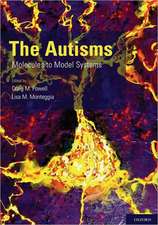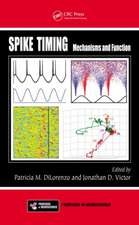Functional Neuroanatomy: Springer Series in Experimental Entomology
Editat de N. J. Strausfeld Contribuţii de M.E. Adams, J. S. Altman, J.P. Bacon, U.K. Bassemir, C.A. Bishop, E. Buchner, H. Bülthoff, S.D. Carlson, Chi Che, F. DelComyn, H. Duve, M. Eckert, T.R.J. Flanagan, G. Geiger, C.H. Hackney, B. Hengstenberg, R. Hengstenberg, N. Klemm, D. R. Nässel, M. O`Shea, W.A. Ribi, R.L. Saint Marie, H.S. Seyan, P.T. Speck, A. Thorpe, Jude, D.W. Wohlersen Limba Engleză Paperback – 21 dec 2011
Preț: 647.92 lei
Preț vechi: 762.26 lei
-15% Nou
Puncte Express: 972
Preț estimativ în valută:
123.100€ • 128.97$ • 102.37£
123.100€ • 128.97$ • 102.37£
Carte tipărită la comandă
Livrare economică 15-29 aprilie
Preluare comenzi: 021 569.72.76
Specificații
ISBN-13: 9783642821172
ISBN-10: 3642821170
Pagini: 448
Ilustrații: XVI, 428 p.
Dimensiuni: 155 x 235 x 24 mm
Greutate: 0.63 kg
Ediția:Softcover reprint of the original 1st ed. 1983
Editura: Springer Berlin, Heidelberg
Colecția Springer
Seria Springer Series in Experimental Entomology
Locul publicării:Berlin, Heidelberg, Germany
ISBN-10: 3642821170
Pagini: 448
Ilustrații: XVI, 428 p.
Dimensiuni: 155 x 235 x 24 mm
Greutate: 0.63 kg
Ediția:Softcover reprint of the original 1st ed. 1983
Editura: Springer Berlin, Heidelberg
Colecția Springer
Seria Springer Series in Experimental Entomology
Locul publicării:Berlin, Heidelberg, Germany
Public țintă
ResearchCuprins
1 Electron Microscopy of Golgi-Impregnated Neurons.- I. Introduction.- II. General Description of the Procedure.- III. Results.- IV. Discussion.- V. Appendix: Schedules.- 2 Block Intensification and X-Ray Microanalysis of Cobalt-Filled Neurons for Electron Microscopy.- I. Introduction.- II. Method.- III. Ultrastructure.- IV. Identification of Size and Nature of Precipitate.- V. Discussion.- VI. Applications.- 3 Horseradish Peroxidase and Other Heine Proteins as Neuronal Markers.- I. Introduction.- II. The Versatility of Exogenous Heme Proteins as Neuronal Markers.- III. Chemistry of Peroxidase-Active Proteins and Reactions for their Demonstration.- IV. Methods.- V. Cytology of Peroxidase-Labelled Neurons.- VI. Mechanisms of Neuronal Uptake and Transport of Herne Proteins.- VII. Concluding Remarks.- VIII. Addendum.- IX. Appendix 1: Method.- X. Appendix 2: Solutions.- 4 Intracellular Staining with Nickel Chloride.- I. Introduction.- II. Method.- 5 Rubeanic Acid and X-Ray Microanalysis for Demonstrating Metal Ions in Filled Neurons.- I. Introduction.- II. Use of Different Metal Ions.- III. Rubeanic Acid Development.- IV. Applications of Rubeanic Acid Development.- V. X-Ray Microanalysis for Detection of Metal Ions.- VI. Conclusion.- 6 Double Marking for Light and Electron Microscopy.- I. Introduction.- II. Double Marking for Light Microscopy.- III. Double Marking for Light and Electron Microscopy.- IV. Alternative Strategies.- 7 Lucifer Yellow Histology.- I. Introduction.- II. Filling from Electrodes.- III. Passive Back- or Forwardfilling.- IV. Fixing.- V. Buffers, Ringers.- VI. Whole-Mount Viewing.- VII. Embedding and Sectioning.- VIII. Microscopy.- IX. Photography.- X. Fading.- XI. Reconstructions.- XII. Geography.- XIII. Storage.- XIV. Artefacts.- XV. Conclusions.- 8 Portraying the Third Dimension in Neuroanatomy.- I. Introduction.- II. Why Computer Graphics in Neuroanatomy?.- III. Designing the System.- IV. The NEU System.- V. Alignment of Sections.- VI. Interactive Profile Acquisition.- VII. Noninteractive Operations.- VIII. Final Remarks.- 9 Three-Dimensional Reconstruction and Stereoscopic Display of Neurons in the Fly Visual System.- I. Introduction.- II. Procedure.- III. Hardware Configuration.- IV. The Data Acquisition Program HISDIG.- V. The Reproduction Program HISTRA.- VI. Stereoscopic Vision.- VII. Examples of Displays and Stereopairs.- VIII. Further Applications.- IX. Concluding Remarks.- 10 Laser Microsurgery for the Study of Behaviour and Neural Development of Flies.- I. Introduction.- II. The Laser Microbeam Unit.- III. Procedure of Laser Surgery.- IV. Histological Analysis.- V. Anatomical-Behavioural Correlations of Laser-Eliminated Lobula Plate Neurons.- VI. Aspects of Neuronal Development.- VII. Discussion.- 11 Anatomical Localization of Functional Activity in Flies Using 3H-2-Deoxy-D-Glucose.- I. Introduction.- II. Essentials of the Technique.- III. Results.- IV. Concluding Remarks.- 12 Strategies for the Identification of Amine- and Peptide-Containing Neurons.- I. Introduction.- II. Neutral Red: A Nonspecific Stain for Amine-Containing Neurons.- III. Neutral Red: An Indicator of Peptidergic Neurons.- IV. Permanent Preparations of Vital Staining with Neutral Red.- V. Use of Immunohistochemical Approaches to Neuron Identification.- VI. Immunohistochemical Screening: Whole-Mount Method.- VII. Identification: Immunohistochemistry and Dye Injection.- VIII. Confirmation of Immunohistochemistry: Cell Isolation, Extraction and Assay.- IX. Concluding Remarks.- 13 Immunochemical Identification of Vertebrate-Type Brain-Gut Peptides in Insect Nerve Cells.- I. Introduction.- II. Immunocytochemistry: Basic Principles.- III. Techniques of Immunocytochemistry.- IV. Problems of Specificity.- V. Brain-Gut Peptides in Insects.- VI. Extraction and Purification.- VII. Conclusions.- VIII. Appendix 1: Immunofluorescence: The Indirect Method.- IX. Appendix 2: Immunoperoxidase: The PAP Method.- 14 Immunocytochemical Techniques for the Identification of Peptidergic Neurons.- I. Introduction and Survey.- H. Preparation of Antigens.- III. Production and Isolation of Antibodies.- IV. Absorption of the Antisera Before Use for Immunocytochemistry.- V. Isolation of Hapten-Specific Antibodies.- VI. Methods for Antibody Isolation.- VII. Immunocytochemical Techniques.- VIII. Immunocytochemical Staining Methods.- IX. CoCl2 Iontophoresis and Indirect Immunofluorescence Method.- X. Supplementary Methods.- XI. Electron Microscopy.- XII. Conclusions.- 15 Detection of Serotonin-Containing Neurons in the Insect Nervous System by Antibodies to 5-HT.- I. Introduction.- II. General Considerations of Antibody Staining.- III The Immunofluorescence Technique.- IV. Fluorescence Microscopy and Photography.- V. The Unlabelled Antibody Enzyme Method for Sections.- VI. A Whole-Mount Method for Antibody Staining.- VII. Specificity of Anti-5-HT Labelling.- 16 Monoaminergic Innervation in a Hemipteran Nervous System: A Whole-Mount Histofluorescence Survey.- I. Introduction.- II. Materials and Methods.- III. Results.- IV. Discussion.- 17 Identification of Neurons Containing Vertebrate-Type Brain-Gut Peptides by Antibody and Cobalt Labelling.- I. Introduction.- II. Method.- III. Interpretation of the Results.- IV. Conclusions.- 18 Interpretation of Freeze-Fracture Replicas of Insect Nervous Tissue.- I. Introduction.- II. Procedure.- III. Interpretation of Replicas.- IV. The Cleaved Cell: A Survey.- V. Recent Advances and Future Prospects.- 19 High-Voltage Electron Microscopy for Insect Neuroanatomy.- I. Introduction.- II. Rationale for HVEM for Biological Research.- III. Method.- IV. HVEM of Insect Neurons.- References.





























